Browse Houses
Search Results: Returned 5516 records. Displaying results 1401 – 1500
| House name | Description | |
|---|---|---|
| Castletown | At the time of Griffith's Valuation, James Fenton was leasing the house at Castletown to George Fenton when it was valued at £10. In 1906 the property at Castletown was owned by Thomas G. Fenton and was valued at £11. It is no longer extant though traces of walls, stable yard and gate lodges are all still visible. | |
| Castletown | A branch of the Ellison family was living at Castletown in the 1770s and Wilson notes it as the seat of Mr. Ellison in 1786. The sale rental for the D'Arcy estate in the Encumbered Estates' Court in November 1852 refers to a small house on the property, which could be adapted as a fishing or shooting lodge. Lewis Strachan occupied the house at the time of Griffith's Valuation. A few walls of the house still remain. |

|
| Castletown | The main residence of the Waller family in the 18th and 19th centuries, now demolished. The house was valued at £80 in the early 1850s when it was the residence of the Reverend William Waller. By 1906 its value was reduced to £72.5 shillings and it was occupied by the Reverend John Thomas Waller who was also resident in 1894. The surveyor for the Irish Tourist Association Survey in 1944 refers to the house being recently levelled to the ground. | |
| Castletown | The home of James Uniache in 1814 and of Norman Uniacke in 1837. Robert Uniacke held the property in fee at the time of Griffith's Valuation when it was valued at £20. In 1786 Wilson also refers to it as the seat of James Uniacke. This house was a ruin at the beginning of the 21st century but the National Inventory of Architectural Heritage refers to its restoration. |
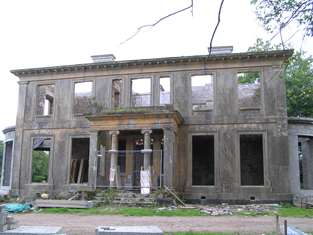
|
| Castletown | ''Burke's Irish Family Records'' states that Castletown was purchased by Thomas Sadleir of Sopwell Hall from the family of his brother-in-law, John Briggs of Castletown, in 1706. It passed to Charles, the second son of Thomas Sadleir and was in the possession of his descendants for four generations. In 1747 it was leased to the Cambies by Charles Sadlier. Wilson mentions it as a Parker seat in 1786. In 1814 Leet records the house as unoccupied. C. Cambie was the occupier when Castletown was described by Lewis as a “a handsome castellated building”. Charles Cambie held Castletown from Thomas Sadlier at the time of Griffith's Valuation when the house was valued at £23. Castletown was sold in the Encumbered Estates Court in 1856, Miss Sarah Cambie was the tenant. Thomas Towers of Bushy Park, Borrisokane was the petitioner. He was married to Elizabeth Cambie and Castletown became their home. In 1906 the occupant was Thomas Towers and the house was valued at £24+. In the 1940s Miss Towers and her nephew Mr. Sterling were the occupiers. This 17th century fortified house with early 19th century additions is still in use as a family residence. It was also known as Castle Cambie. |
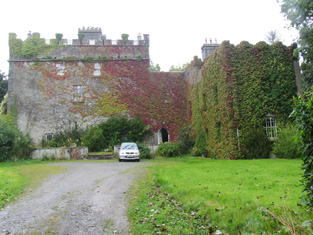
|
| Castletown (Ballysadare) | A house named Castletown appears on the 1st ed. OS Map in the townland of Cloonmacduff. At the time of Griffith's Valuation, Edward J. Cooper owned a gardener's house here valued at £1. The property is now almost completely overgrown. Historians have speculated that this may also be the location of the original seat of Lord Collooney, later acquired by the Coopers. | |
| Castletown Conyers | The seat of the Conyers family, occupied by C. Conyers in the early 19th century. By the time of Griffith's Valuation the house appears to be in use as an auxiliary workhouse, held by the Croom Guardians from William Bailey, medical doctor, and valued at £25. In 1894 it was the residence of Charles Conyers. |

|
| Castletown Cottage (Inishowen) | Joseph Gilligan was leasing this property from the Dogherty estate at the time of Griffith’s Valuation, when it was valued at £14. This property is still extant. |
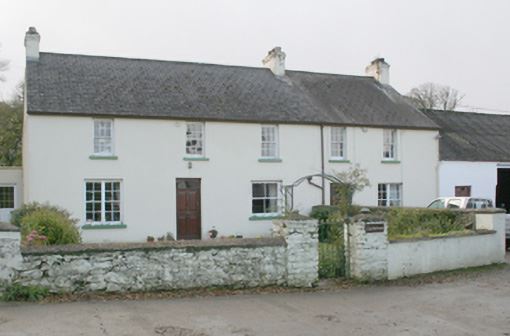
|
| Castletown House | The original house is now demolished and a 20th century house stands on the site close to an old Macnamara castle. The house was occupied by Francis Macnamara in 1814 and by Robert Malcolm in the mid 19th century who held it from Colonel George Wyndham. It was valued at £10. | |
| Castletownsend (Coghill) | Sir Jocelyn Coghill was leasing this property from Rev. M. Townsend at the time of Griffith's Valuation, when it was valued at £22 10s | |
| Castletownsend (Herbert) | Mary Herbert was leasing this property from Rev. M. Townsend at the time of Griffith's Valuation, when it was valued at £25. There were a number of marriages between members of the Townsend family and the Herberts of Muckross, Killarney. | |
| Castleturvin | Francis Bruen was leasing Castleturvin to Reverend Mark Perrin at the time of Griffith's Valuation. The Ordnance Survey Name Books claim that the Turvin family were the proprietors in the 1830s. Castleturvin House is still extant and occupied. The entrance gate indicates that the house dates from 1767. |

|
| Castleview | Occupied by Brian Sheehy in 1814 and by Thomas Locke in 1837. At the time of Griffith's Valuation Castleview was the residence of the Rev Robert M. Rodwell, the buildings were valued at £30. Birthplace of William John Locke Travers in 1819, a New Zealand lawyer, politican and naturalist, see http://www.teara.govt.nz/1966/T/TraversWilliamThomasLocke/TraversWilliamThomasLocke/en | |
| Castleview | Castleview was the home of the Gumbleton family held from Henry Peard in the mid 19th century and valued at £68.15 shillings. The house remained in Gumbleton possession until the early 20th century but is now demolished. Bence Jones lists this house under the name Glynnatore and writes that it was built in 1791 by R. W. Gumbleton. In 1894 Slater notes Glenatore as the seat of Mrs. Gumbleton. | |
| Castleview | A Jackson property which was unoccupied in 1837. By the time of Griffith's Valuation Robert Delacour Beamish was resident in the house valued at £34 which he held from the Jacksons. The house was sometimes known as Ditchley House. Now functions as the Radisson Hotel, Little Island. |

|
| Castleview House | At the time of Griffith's Valuation, Robert Leeson was leasing this property to Edward Hartnett when it was valued at £11. On the 1st edition Ordnance Survey map it is labelled as Charter School but by the 1893 edition it is named as Castleview House. Bary indicates that the property was originally built in the mid-eighteenth century and operated as a Charter School until the 1820s. Papers relating to its operation as a charter school are included in Ms.17,973 [Quane Papers] in the National Library of Ireland. It was later enlarged by the Hartnett family who occupied it for much of the nineteenth century. It is still extant and occupied. |
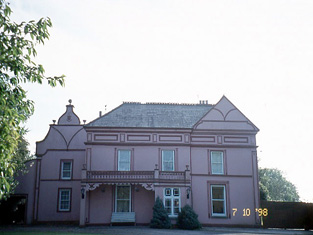
|
| Castleview or Inishannon House | Abraham Bazly was leasing this property from Sir Riggs Falkiner at the time of Griffith's Valuation when it was valued at £9. It is named Castleview on the 1st edition Ordnance Survey map but as Inishannon House on the later 25-inch edition of the 1890s. Modern housing exists at the site now. | |
| Castlevilla | A Ruttledge family home in the 19th century, still extant and lived in. At the time of Griffith's Valuation it was leased by James Rutledge from Lady de Clifford's estate and valued at £18. |
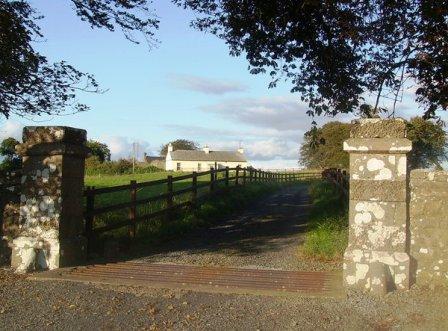
|
| Castlewarren | Robert Warren was leasing this property from Mary and Catherine Rogers at the time of Griffith's Valuation, when it was valued at £35. In 1837 Lewis referred to it as a "spacious mansion erected in 1796, the seat of R. Warren". Townsend refers to it as the seat of Thomas Warren "whose style of farming is conducted on the best principles of modern art". It was included in the sale of Warren's estate in October 1850. Now a ruin. | |
| Castlewray | The Wray family were associated with this locality since the seventeenth century. Local sources suggest that Castlewray was sold by the Wrays to the Mansfield family around 1800. At the time of Griffiths Valuation in the 1850s, it was occupied by Margaret Mansfield, leasing from Francis Mansfield and valued at £16. It is now a ruin. | |
| Castruse House | William Cochrane was leasing this property from Robert Bateson at the time of Griffiths Valuation in the 1860s when it was valued at £12. It is labelled Castruse Huose on the 25-inch map of the early 20th century. In the 1870s John Motherwell's address is given as Castruse. The National Inventory of Architectural Heritage suggests it was built in the last years of the 18th century on the site of an earlier house. It is still extant and occupied. |
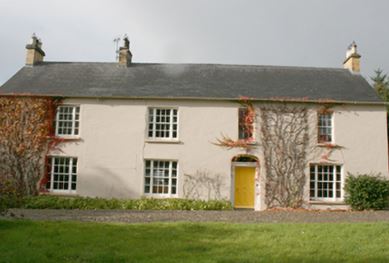
|
| Cavan (Raphoe) | The representatives of John Wilson were leasing this property from Alexander Stewart's estate at the time of Griffiths Valuation, when it was valued at almost £13. A house and substantial farm are still extant at the site. | |
| Cavanacor | This property was held in fee by Benjamin [Humfrey] at the time of Griffiths Valuation, when it was valued at £33. Wilson referred to it as the seat of "Mrs Kays" in 1786. The National Inventory of Architectural Heritage suggests it was built about 177-, possibly incorporating part of a seventeenth century house. It is still extant and occupied. |
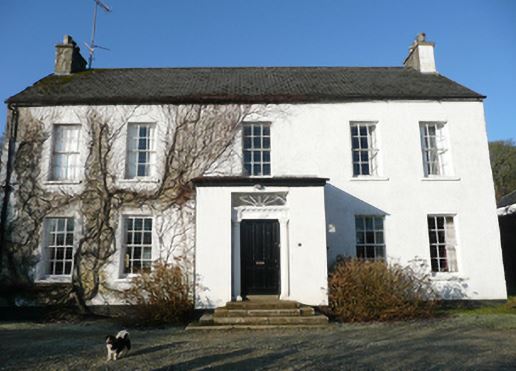
|
| Cavangarden House | Thomas J. Atkinson held this property in fee at the time of Griffith’s Valuation, when it was valued at £20. It still held this valuation in 1906. A second property in the townland, valued at almost £8, was occupied by John Atkinson, leasing from William Atkinson. Lewis had also noted it as a seat of the Atkinson family in 1837. Cavangarden is still a working farm where guest accommodation is provided. | |
| Cavelawn | Guy Lloyd was leasing a house at Faus valued at £10 to James Acheson at the time of Griffith's Valuation. The house at this site is labelled Cavelawn on the 25-inch Ordnance Survey map of the 1890s. A house is still extant at the site. | |
| Cavetown | In 1786 Wilson notes Cavetown as the seat of the Rev. Dean Mahon and the Reverend Arthur Mahon resided there in 1814. At the time of the first Ordnance Survey a ''gentleman's seat of two stories'' is noted in Cavetown. Guy Lloyd is recorded as the proprietor. This may be the property, valued at £5, leased from the Lloyd estate by Geo. Laird at the time of Griffith's Valuation. There are buildings still extant at this site. |

|
| Cecilstown Lodge | A home of members of the Wrixon family in the late 18th and early 19th centuries. Occupied by William Wrixon, father of Sir William Wrixon Becher, in 1837. It was leased to Thomas Heffernan from the 1840s. Valued at £9 in the early 1850s it was later occupied by members of the clergy including the Reverend E.G. Jones, whose widow bought the house in the early 20th century. It was burnt in June 1921 during the War of Independence when it was the residence of the sisters, Esther Jane and Annie Jones. A house, however, still exists at the site. | |
| Cellmount House | Wilson, writing in 1786, refers to "Selmount House" as a seat of Mr. Morris, three miles from Ross Carbery. This property is labelled "Cellmount House, in ruins" on the 1st edition Ordnance Survey map and there is no trace of it on later maps. | |
| Chadville | A house valued at £11 occupied by William Ryan and held from Hugh B. Bradshaw in the mid 19th century. Later in the nineteenth century it was associated with Valentine Ryan, who held large estates in County Donegal and in Queen's County. This house is still in use as a residence. |

|
| Chaffpool | Chaffpool House was the centre of the Armstrong estate in the 19th century having previously belonged to the Somers family. At the time of Griffith's Valuation it was owned by Catherine Armstrong and was valued at £35. In 1906 it was occupied by the representatives of Edward Armstrong and was valued at £49. It was also recorded as a seat of the Armstrong family by Lewis in 1837. Extensive remains of walled garden, stable and a later (c.1890s) house remain. |

|
| Chancellorstown House | In 1786 Wilson refers to Chancellors' Town as the seat of Mr. Moore. The house and surrounding demesne are shown on the first edition Ordnance Survey map but are not marked on the 25-inch edition of the 1890s. The townland was part of the estate of Stephen Moore at the time of Griffith's Valuation, though the house was leased by the representatives of Joseph Gough to Denis Daly and was valued at £7 10s. Farm buildings occupy the site now. | |
| Chapel Park | At the time of Griffith's Valuation Thomas Jones was both a lessor and an occupier of lands in three townlands in Clontuskert parish, barony of Clonmacnowen. This included a property valued at almost £3 at Chapel Park. A farm with modern buildings is extant at the site now. | |
| Charlemont House | Charlemont House was leased by Charles Evanson from Nicholas G. Allen at the time of Griffith's Valuation, when it was valued at £20. It was included in the sale of Evanson property in the Landed Estates Court in November 1862. It is still extant. | |
| Charlesfort House | Charlesfort House was the home of Rev. William Grove in 1836. It was also occupied by him at the time of Griffith's Valuation when it was valued at £13. | |
| Charlestown House | In 1786 Wilson refers to Charlestown as the "the fine seat of Mr. King, most delightfully situated on the Shannon". The first Ordnance Survey map marks both Charlestown House and Charlestown Old House closeby at M984 976. Valued at £46 at the time of Griffith's Valuation. In 1894 Charlestown was the residence of Sir Gilbert King. The house is no longer extant but extensive estate architecture survives. |

|
| Charleville | A late 18th century house, the main residence of the family until 1865. Held in fee by Charles L. Fitzgerald at the time of Griffith's Valuation when the buildings were valued at £20. It is now a ruin. | |
| Chateau Marie or East View | Held by Francis Allen but unoccupied in 1851 when it was valued at £30. Lewis refers to it as the seat of F. Allen in 1837. It is labelled Chateau Marie on the First Edition Ordnance Survey Map but as East View on the later 25-inch edition of the 1890s. Now a country house used for private functions. |

|
| Cherry Cottage | A house inhabited mainly by agents to the Marquess of Sligo, including George Hildebrand in the mid nineteenth century and George Taylor in the early 20th century. At the time of Griffith's Valuation it was valued at £15. The Hastings interest in this house was sold in the Landed Estates' Court in November 1874. It is still extant. |

|
| Cherry Vale (Aghnamullen) | Located at the southern tip of Lough Egish, Cherry Vale was situated in the midst of a linen manufacturing enterprise. Some deeds record George Crawford, linen draper, of Cherryvale at the end of the 18th century. Cherry Vale became part of the McTear of Belfast estate. The Ordnance Survey Field Name Book records the house as small with two stories. At the time of Griffith’s Valuation it was occupied by Thomas Johnston, who held it from Eliza McKean who in turn was leasing from George McTear. | |
| Cherryfield | Home of the Mills family in 1778. Noted by Wilson as "the fine seat of Oliver Mills" in 1786. Lewis refers to it as a seat of the same family in 1837. It was occupied by Michael Butler in the 1850s and held from John Carroll, valued at £10. It came into the ownership of the McGreavy family in the latter part of the nineteenth century and remained in their possession until the 1960s. It is now derelict. | |
| Cherrygrove | Cherrygrove was the home of Edward Cripps in 1814 and of J. Barry in 1837. At the time of Griffith's Valuation it was occupied by Edward John Sheehy who held the property from Robert Harding. The buildings were valued at £21+. The Misses Sheedy were still in residence in the 1940s. A building is still extant at the site. | |
| Cherrymount (Ballyshannon) | Cherrymount was leased from Forbes Johnston’s estate by Hugh Tuthill at the time of Griffith’s Valuation, when it was valued at £16. Lewis recorded it as the seat of Dr. Crawford in 1837. In 1867 Forbes Johnston offered 160 acres of Cherrymount for sale in the Landed Estates Court. The sale notice stated that Hugh Tuthill's lease began in 1854, for 21 years. The property is labelled Cherrymount on the 1st and 25-inch Ordnance Survey maps. It was submerged under the waters of Assaroe Lake in the 1940s as part of the Erne Hydro Electric Scheme | |
| Cherrymount House | Described by Lewis in 1837 as the "occasional residence" of Captain Parker. It was being leased by Thomas Carpenter from the Parker estate at the time of Griffith's Valuation, when it was valued at £24 10s. In 1852 it was offered for sale in the Encumbered Estates Court when it was described as "a suitable dwelling house and demesne, formerly occupied by the owner". It was purchased by Maj-Gen Sir Joseph Thackwell and remained in the possession of that family until the twentieth century. It is now a ruin. | |
| Chesterfield | Occupied by Maurice P. O. [P]helan in 1814 and by Major Sullivan in 1837. Held from the Major's representatives in the early 1850s and occupied by Francis Brown. The buildings were valued at £18. There is a modern house at the site but the stableyard and farm buildings still survive. |
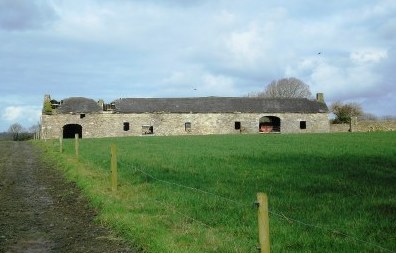
|
| Chesterfield | A property named Chesterfield is recorded on the 1st edition OS Map, located at Cloonineen, parish of Kiltormer. At the time of Griffith's Valuation, Thomas S. Eyre owned this townland amounting to over 300 acres and also held a herd's house there valued at 15s. The property is still labelled Chesterfield on the 25-inch map of the 1890s but is much reduced. It is no longer extant. | |
| Chetwynd | The Pigotts were established at Chetwynd in the early 18th century and Wilson refers to it as their seat in 1786. By the end of the century they were resident in county Laois. In 1837 J. Forrest was the proprietor of Chetwin and in the mid 19th century William Bateman occupied the house, valued at £25, which he held from John Dennis. Two houses are marked on the first Ordnance Survey map for Chetwynd. It is not clear which one was the Pigott house. | |
| Chevy Chase Cottage. | William Arthur Persse was the owner of a house valued at almost £10 at Laherdaun in 1906. It had been the property of Dudley Persse at the time of Griffith's Valuation. It was probably used mainly as a hunting lodge due to its remote location. Ruinous fragments remain, surrounded by state forestry. |
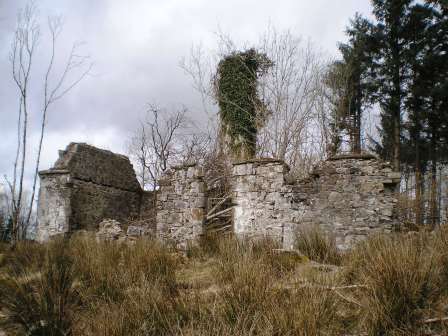
|
| Chilhame/Chilham | ||
| Christendom House | At the time of Griffith's Valuation, Benjamin Whitney was leasing this property from the Rea estate when it was valued at £32 10s. This house is no longer extant. | |
| Church Hill | This house with a view to Muckno Lake is marked on the 1st edition 6 inch Ordnance Survey Map (1836). It had quite extensive gardens and a block of outbuildings. It was the home of the Harrison family from at least the early 19th century as George Harrison is recorded in the Tithe Applotment Book (1827). The buildings were valued in the mid-19th century at £7.5.0. George Harrison was the occupier holding the property from Henry T. Hope. Another member of the Harrison family, Francis, occupied a herd’s house close by. Members of the Harrison family still lived in this townland in the early 20th century. | |
| Church Hill | This house, with a view to Muckno Lake, is marked on the 1st edition 6 inch Ordnance Survey Map (1836). It had quite extensive gardens and a block of outbuildings. It was the home of the Harrison family from at least the early 19th century as George Harrison is recorded in the Tithe Applotment Book (1827). The buildings were valued in the mid-19th century at £7.5.0. George Harrison was the occupier holding the property from Henry T. Hope. Another member of the Harrison family, Francis, occupied a herd’s house close by. Members of the Harrison family still lived in this townland in the early 20th century. | |
| Church Hill | Occupied by Charles McCarthy in 1814 and by Daniel McCartie in 1837. Mary McCartie occupied the house in the early 1850s holding it from Anne McCartie. It was then valued at £5.10 shillings. Hajba writes that the last McCartie to live at Church Hill was Richard. The property was sold to the Shine family in the late 19th century and there are only some ruined remains of the house. | |
| Church Hill House | At the time of Griffith's Valuation, Rev. Mountifort Longfield was leasing this property from Susan McDonnell, when it was valued at £24. [This may be Susan McDaniel of Bandon, as Daniel McDaniel of Knockmacool, is listed in a Bandon Directory of 1876]. Lewis records the house as the seat of Mountifort Longfield in 1837. It is still extant. |

|
| Church Hill House | At the time of Griffith's Valuation, Rev. Henry Denny was leasing Church Hill from Sir Edward Denny when it was valued at £27. According to Bary the house was in the hands of the Denny family for much of the eighteenth and nineteenth centuries until it passed to the Neligans, possibly in the 1880s. In 1906 it was owned by William Neligan and valued at £27. It is still extant and occupied. |

|
| Church Park | Church Park was occupied by Benjamin Reeves in 1814. It is shown on the First edition Ordnance Survey map of the 1840s but is not labelled on the later 25-inch edition of the 1890s. The house is no longer extant but entrance gates are still visible. | |
| Churchboro | Occupied by Edward Kelly in 1814, E. Kelly in 1837 and by Patrick Grehan at the time of Griffith's Valuation. The house is no longer extant. |

|
| Churchfield House | Dr Langer Carey was a member of the Careyville family. He lived at Churchfield House, Newport in the mid 19th century, valued at £17.10 shillings and held from Lady Waller. A house is still extant at the site. | |
| Churchtown | At the time of Griffith’s Valuation, Sir A. Blennerhassett was leasing Churchtown House to Robert Stokes. In 1837 Lewis refers to it as the seat of Sir A. Blennerhassett. Leet mentions it as the residence of R.A. Blennerhassett in 1814. The house was valued at £31. Churchtown House is still extant. Much of the demesne is now part of Beaufort Golf Course. |
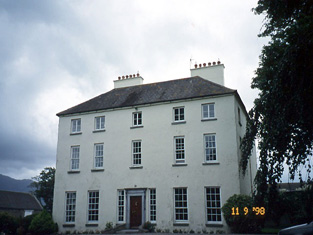
|
| Churchtown House | Located on the Egmont estate Churchtown House was the residence of the Crofts family in the 18th and early 19th centuries. Occupied by George Crofts in 1814 and by the Reverend F.W. Crofts in 1837. By the time of Griffith's Valuation it was owned by Sir Edward Tierney in fee and valued at £44. Later 19th century occupants were Major Trench and John Cowhey. This house is still extant and occupied. |

|
| Churchtown House (Dysert) | Leased from the Disney estate by James Connolly at the time of Griffith's Valuation, when it was valued at £25. In 1837 Lewis notes Churchtown as " the pleasant residence of John Power". In 1777, Charles Smith refers to it as the seat of Eccles Disney. The house is still extant. It was partially renovated in the early 21st century and in 2010 was offered for sale. |
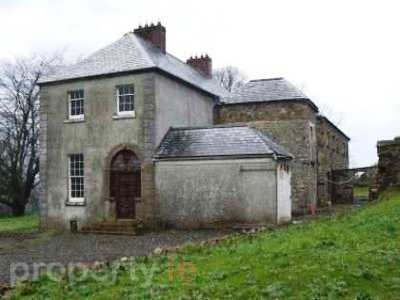
|
| Chute Hall | Richard Chute was occupying Chute Hall at the time of Griffith's Valuation, when it was valued at £37 10s. Lewis also records it as his residence in 1837. The house is named "Tullygarran House" on the 1st edition of the Ordnance Survey map and is so described in the Ordnance Survey Name Books where it is noted it was "three stories high and about a century old". The house later became known as Chute Hall. Bary notes that the Chutes had been resident in this area since the seventeenth century on what had been McElligott land. In 1894 it was the residence of Mrs. Chute. Richard, the last of the Chutes to live here, died in 1936. In 1943 the Irish Tourist Association Survey noted Chute Hall "now almost a wreck but once a fine imposing structure." The house has been demolished but the substantial gateway remains inside which are some fine ogham stones. |

|
| Ciamaltha House | Builtby Lord Benjamin Bloomfield, ADC to George III, as a sporting lodge, the Ordnance Survey Name Books describe it as "recently erected" in 1840. Lewis writes in 1837 "Lord Bloomfield is building a handsome lodge in the Elizabethan style and has laid out an extensive nursery from which considerable plantations have been made on the surrounding mountains". At the time of Griffith's Valuation this house was valued at £58+ and was held in fee by Lord Bloomfield. The 1906 report on Untenanted Demesnes claims that the house was occupied by his daughter, the Honourable Harriott Kingscote, who, in 1833, had married Thomas Henry Kingscote of Gloucestershire. However, family sources indicate that the house was actually occupied in the early 1900s by her grandson, Col. Randolph Kingscote, who continued to live there until 1922. The house is still in use as a residence. |

|
| Clancool House | Held in fee by Thomas W. Hewitt at the time of Griffith's Valuation, when it was valued at £25. Lewis refers to Clancool as the seat of Mrs. Gillman in 1837. This house is still extant. |
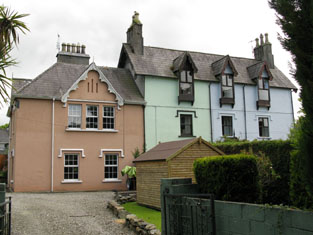
|
| Claragh (Kilmacrenan) | James Watt was leasing this property from the estate of the Ecclesiastical Commissioners at the time of Griffiths Valuation in the 1850s, when it was valued at £28. By 1906 it was also owned by James Watt with a valuation of £66. A substantial collection of buildings remains at the site. |
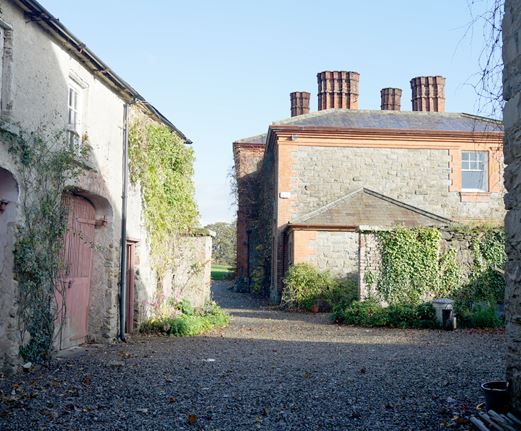
|
| Claran House | The home of the Browne family in the 19th century. It was occupied by Arthur Dillon Browne in the early 20th century. |

|
| Clare Mount (Inishowen) | William Holton was leasing the house at Clare from the Young estate at the time of Griffiths Valuation in the 1850s, when it was valued at £10. The National Inventory of Architectural Heritage suggests the current house was built c.1870 but on the site of an earlier building. | |
| Claregalway Castle | In 1786 Wilson refers to "the ancient castle of Clare-Galway, the seat of Michael French". Both the 1st edition and 25-inch edition indicate that the original tower house was in ruins but extensive adjacent buildings are shown on the 25-inch map. At the time of Griffith's Valuation, it was part of Lord Clanmorris's estate and was leased to Patrick Reilly when the buildings were valued at over £5. The castle is still extant and undergoing a programme of renovation. | |
| Claremont | Described in the Ordnance Survey Name Books as a 'neat modern building', the house was located close to the bank of the River Suck. It was the home of Gonville ffrench and he held it from the D'Arcy family. In the D'Arcy sales rental of May 1851 there is reference to 'the splendid mansion' of Gonville ffrench. Occupied by the Honourable Clarinda ffrench in the 1850s who held the property from the Right Honourable Richard W. Greene, valued at £21. The house is now a ruin. |

|
| Claremount | Built in the 18th century, this house was the home of George Browne, third son of the 1st Earl of Altamont, in the 1760s. His daughter and heiress married Dominick Browne of Castlemagarret and ownership of Claremount appears to have passed to the Castlemagarret Brownes. The Kirwans and Denis Browne of Westport lived in the house in the late 18th and early 19th centuries. It was bought by Murray McGregor Blacker from Lord Oranmore and Browne in 1858 for £4,250. Blacker owned the house until 1874. In 1877 the house and about 313 acres were sold to the local parish priest by Thomas D. Maguire for the purpose of establishing a Convent of Mercy. The nuns ran a girls' secondary school in the house. In October 1906 just over 300 acres of Claremount was vested in the Congested Districts' Board. |

|
| Claremount House | Claremount house and demesne were part of the Barntick estate. Occupied by Jonas Studdert in 1814 and by Wyndham F. Patterson at the time of Griffith's Valuation. His lease expired on 25 Mar 1857. It was then leased to the Lynch family. One descendant was Patrick Lynch, Senator of the Irish Free State and Attorney General of Ireland 1936-1940. | |
| Clareville | Weir writes that this house was built by a member of the Joynt family, one of whom was agent to the White estate in the early 19th century. It was valued at just over £5 and was unoccupied at the time of Griffith's Valuation. James and Michael Comyn were the immediate lessors who held over a hundred acres from Colonel Henry White. Clareville was one of the residences of William Lane Joynt in the latter half of the 19th century. An occupied house still exists at this site. |
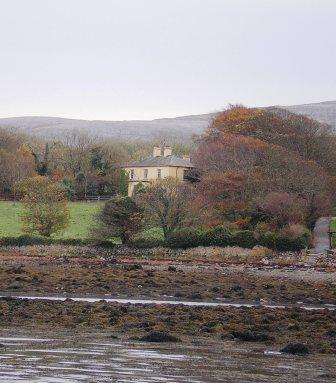
|
| Clareville House | Built in the mid 18th century by Robert Martin of Dangan, it was used as a winter residence by the Martins of Dangan and Ballynahinch Castle. Occupied by Richard Martin at the time of Griffith's Valuation and held from the Law Life Assurance Society when it was valued at £20. Clareville is still extant and occupied. In 2013 it was offered for sale. |
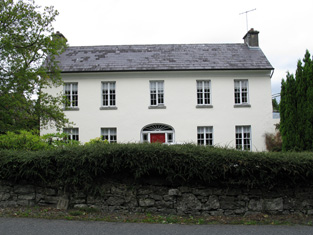
|
| Clashadonagh [Frogmore] | James Barry held an unoccupied house in the townland of Glanaradotia valued at £20 at the time of Griffith's Valuation. It is labelled Clashadonagh on the 1st edition Ordnance Survey map but as Frogmore House on the 25-inch map of the 1890s. It is now a ruin. | |
| Clashagad | ||
| Clashanahy | Sir Richard Musgrave held this property on lease from the Decies estate at the time of Griffith's Valuation, when it was valued at almost £18. There is still an extant property at this site. | |
| Clashanimud Cottage or Glenview House | Rev. George Nash was leasing this property to Henry Nash at the time of Griffith's Valuation, when it was valued at £10. It is labelled on the 25-inch Ordnance Map, published in the 1890s, as Glenview House. There is no house at this site now. | |
| Clashanure | Home of a number of generations of the Allen family in the 18th and 19th centuries. Occupied by the representatives of Kyrle Allen at the time of Griffith's Valuation and held from Robert Meade. The buildings were valued at £15 and the Allens also had a mill valued at £13. Still extant and occupied. |
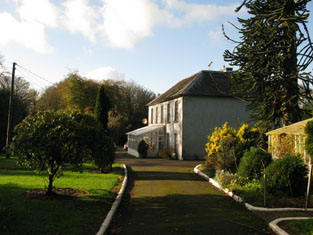
|
| Clashduff | Peter Warner was occupying a house valued at £18 in the townland of Clashduff at the time of Griffith's Valuation. He held this property from Sir A. Brooke. This may be the house recorded by Lewis as Castle View in the parish of Inchinabacky and inhabited by P. Warner. Peter Warner of Clashduff, Middleton owned 205 acres in the 1870s | |
| Clashganniv | Hajba writes that this house has always been the home of the O'Brien family. Vincent O'Brien, the famous Irish race horse trainer, was born at Clashganniv in 1917. The house is still extant and occupied. At the time of Griffith's Valuation there were two houses in Clashganniv, one valued at £16, was occupied by James Lynch and the other valued at £10 was held in fee by Sir Edward Tierney. | |
| Clashganniv House | John Powell was leasing this property from the Herbert estate at the time of Griffithf's Valuation, when it was valued at £10. Let also notes it as his residence in 1814 though he refers to it as Sandville. Bary states that the Powells continued in residence until the early twentieth century. Clashganniv is still extant and occupied. |

|
| Clashleigh | Lewis records Claishleigh as the residence of S. Grubb and in Griffith's Valuation Samuel Grubb held a house, office and flour mill valued at £170 in Clogheen Market from Viscount Lismore. His son Henry Samuel Grubb lived at Claishleigh in the 1870s. This house was in use as a rectory in the 20th century. |

|
| Clashmore | Clashmore was held in fee by the Earl of Huntingdon at the time of Griffith's Valuation, when it was valued at £34. The site marked on the 1st-edition Ordnance Survey map is not that recorded on the later 25-inch map. Smith refers to the earlier house as the seat of Mr. Power and Wilson refers to it as the seat of Richard Power in 1786. The Irish Tourist Authority Survey of the 1940s suggest the later house was never fully completed and by then had all but disappeared. Much of the extensive farmyard, however, is still extant and in use. |
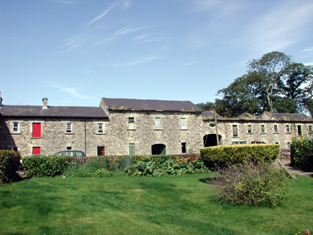
|
| Classas | A house occupied by H. Minhear in 1837 and by Lewis Gollock at the time of Griffith's Valuation when it was valued at £26 and held from William Crooke. In 1894 Slater notes it as the seat of A. McCall. In the 1940s the Irish Tourist Association survey noted that it was then being run by Mrs. Agnes Leader as a guesthouse "for relatives". It is still extant and occupied. |
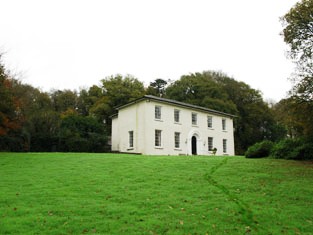
|
| Classes | Classes was occupied by William O'Callaghan in the early 1850s and held from John Stevely. The buildings were valued at £11. There are two houses at Classes on the 1st edition Ordnance Survey map. Classes House is located at W562705 while the second is labelled Classes House East and located at the site of the current Classes House which bears a date label of 1823. |
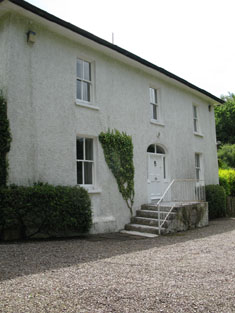
|
| Classiebawn Castle | Classibawn was built for Lord Palmerstown in 1874. It afterwards passed to the Ashley family and is still in the possession of their descendents. In 1906 it was valued at £69. |

|
| Cleaboy House | Patrick Balfe was leasing a property valued at £10 from Teresa Madden at Cleaboy, barony of Castlereagh, at the time of Griffith's Valuation. A house is still extant at the site. | |
| Cleaghmore | Andrew Montgomery was leasing a house valued at £13 from the Clancarty estate at Cleaghmore, parish of Kilcloony, barony of Clonmacnowen, at the time of Griffith's Valuation. | |
| Cleaghmore B & C | At the time of Griffith's Valuation, the Clancarty estate was leasing two houses in this townland to members of the Le Poer Trench family, one (Cleaghmore B) valued at £23 and the other Cleaghmore C) at £21. They were leased by Mrs. Le Poer Trench and Robert Le Poer Trench respectively. | |
| Cleaghmore Villa | A vacant house, valued at £11 and part of the property of Norman Ashe, was located at Cleaghmore, parish of Kilcloony, barony of Clonmacnowen at the time of Griffith's Valuation. This is possibly the house shown on the 25-inch Ordnance Survey map of the 1890s as Cleaghmore Villa which is still extant. |
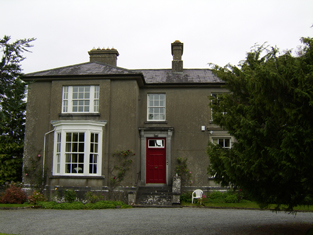
|
| Cleeny | At the time of Griffith’s Valuation, Maurice Brennan was leasing a property at Cleeny, valued at almost £7, from The O’Donoghue estate. In 1906 it was owned by Lord Kenmare's estate and valued at £5 15s. Modern farm buildings are located at the site. | |
| Cleggan | The home of the Twining family for the second half of the 19th century. The house was inherited by Julia Holberton in 1902 and now belongs to her great grandson Hugh Musgrave and his family. |
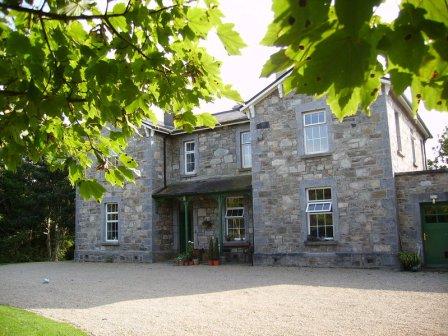
|
| Clenagh Castle | Home of the McMahons in the 18th century, Lewis refers to the ruined tower which was "once the residence of the McMahons". |
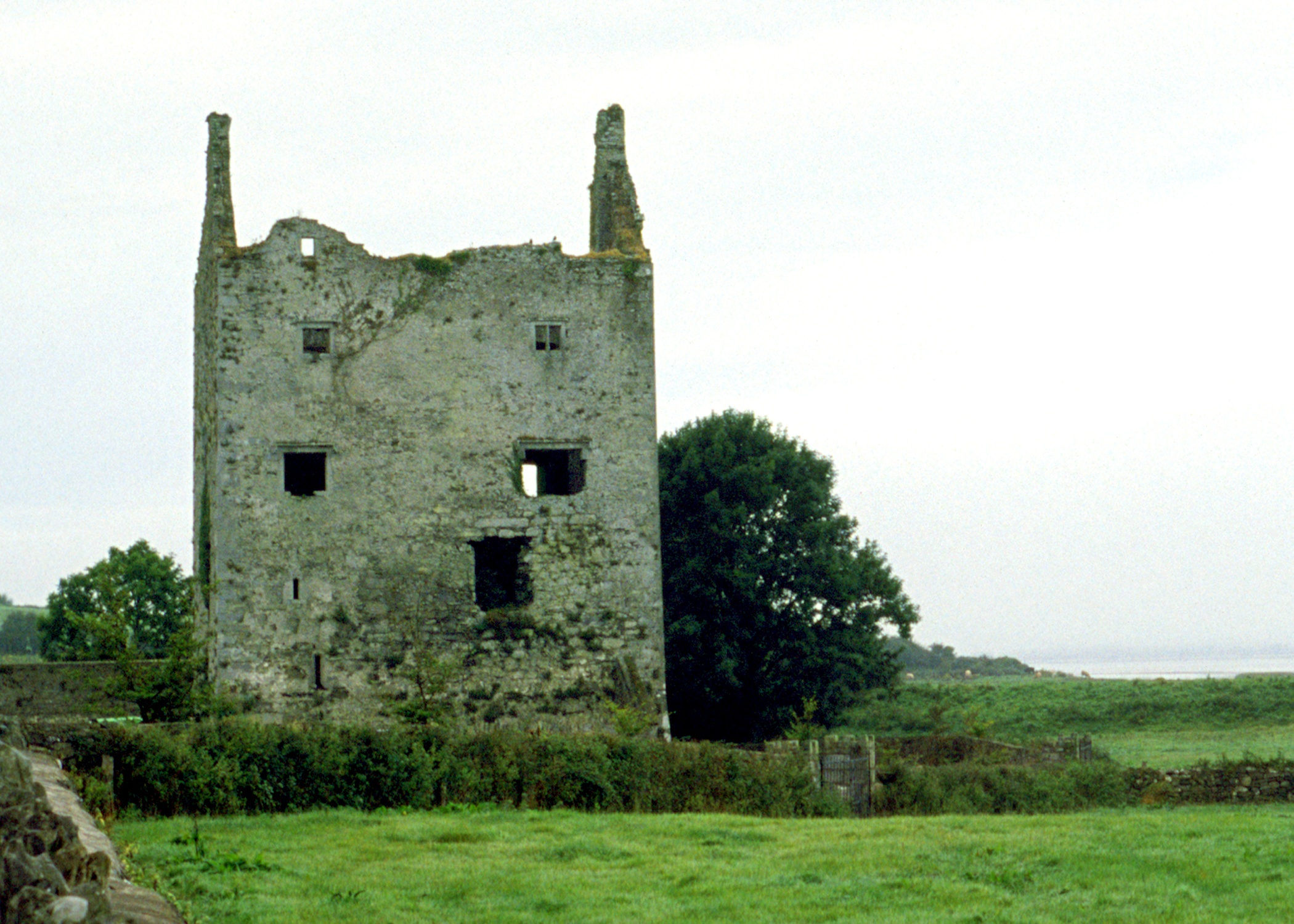
|
| Cleragh House | William Power was living at Cleragh, Killenaule in 1814 and Charles Blackmore was resident in the mid 19th century. Blackmore held the house valued at £13 from Patrick Waldron with 257 acres. This house is still in use as a country residence. |

|
| Clermont House | Clermont or Claremount House, Nenagh, was occupied by William Short in 1814 and by Frederick Evans in 1837. In 1840 the Ordnance Survey Name Books refer to it as "a good dwelling house, the residence of Mr. J. Evans". It was also occupied by Evans at the time of Griffith's Valuation. The house was then valued at £24 and held from the Marquess of Ormond. This house still functions as a residence. |
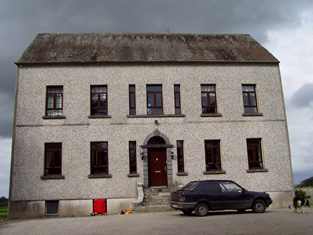
|
| Cleve Hill | Samuel Perrott was residing at Cleve Hill in 1837 and in the early 1850s when the house was valued at £68 and held from Alexander McCarthy. Cleve Hill a modern family mansion on 13 acres was advertised for sale in October 1873, the estate of Joseph Gadsden Nash and Arthur Power Harty, bankrupts. | |
| Cleveragh | Capt. James Martin was the lessor of a property valued at £18 at Cleaveragh Demesne, barony of Carbury at the time of Griffith's Valuation. It was being leased by Robert Wilson. It continued in Martin ownership until the twentieth century though frequently occupied by tenants. The house and demesne were eventually bought by Sligo Borough Council with the intention of creating a town park though this was only partially realised. The house was demolished in 1999. | |
| Clifden | This house was the home of the Burton family on the shore of Inchiquin Lough in the late 18th and 19th centuries. Wilson refers to it as the seat of Edward W. Burton in 1786. It was the residence of Lieutenant Colonel Marcus Patterson in the 1870s and in 1906. The house is still extant. |
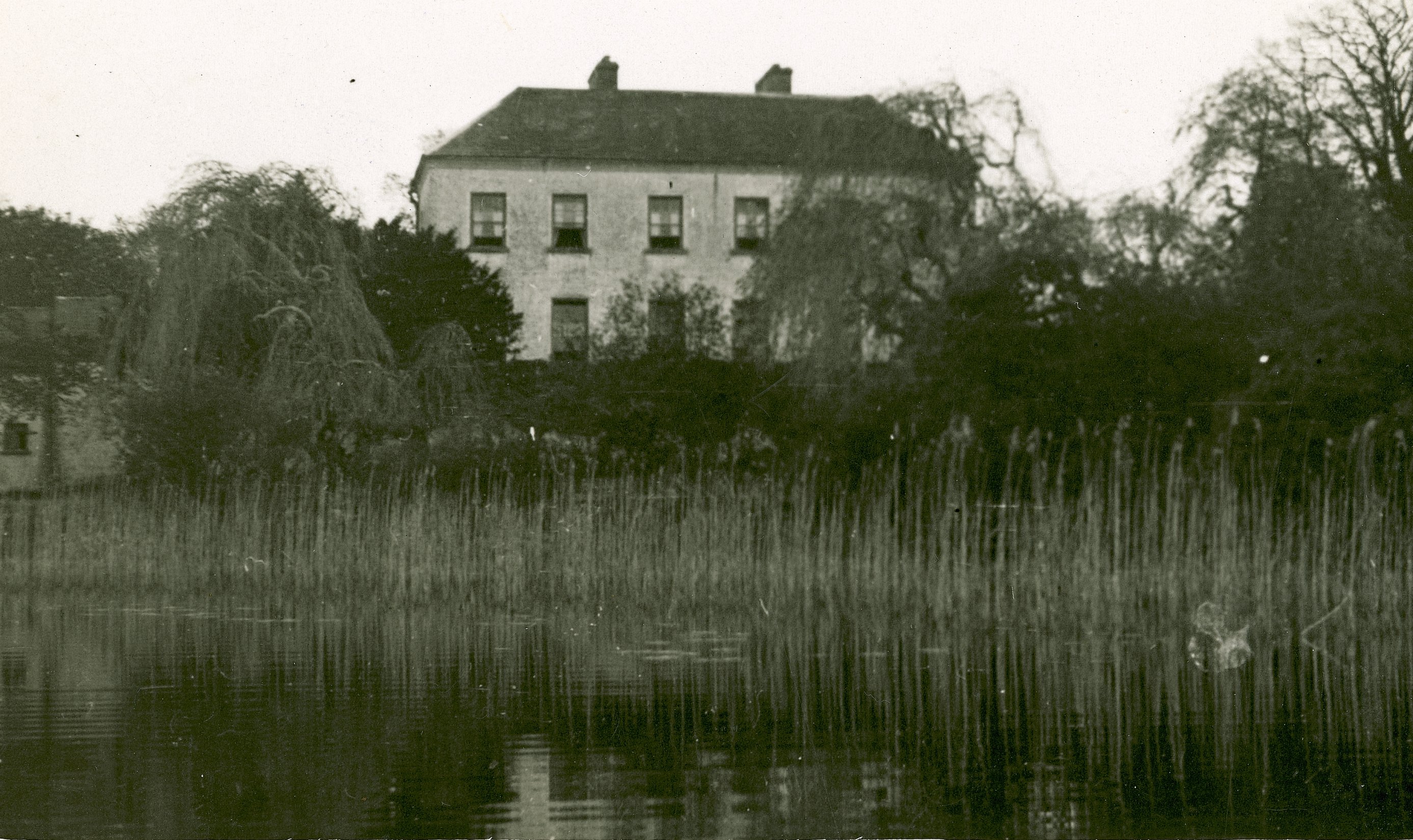
|
| Clifden Castle | Built circa 1818 by John D'Arcy and home to his family until 1850 when it was sold to Thomas Eyre. Left by him to his nephew John Joseph Eyre and sold by his representatives to a local butcher in 1917. It is now a ruin. A lithograph of the house is part of the sales rental 1850. |

|
| Cliff Fort | Thomas Frewen held this property in fee at the time of Griffith's Valuation, when it was valued at almost £7. There is still a house at this site. | |
| Cliff Lodge/Cliff Cottage | In 1848, Patrick Keely was leasing this property from the Barron estate when it was valued at almost £14. It is labelled as Cliff Lodge on the 1st-edition Ordnance Survey Map but as Cliff Cottage on the 25-inch edition of the 1890s. The house is no longer extant. |

